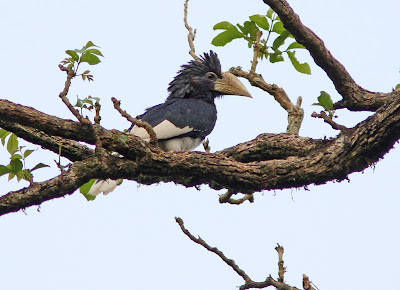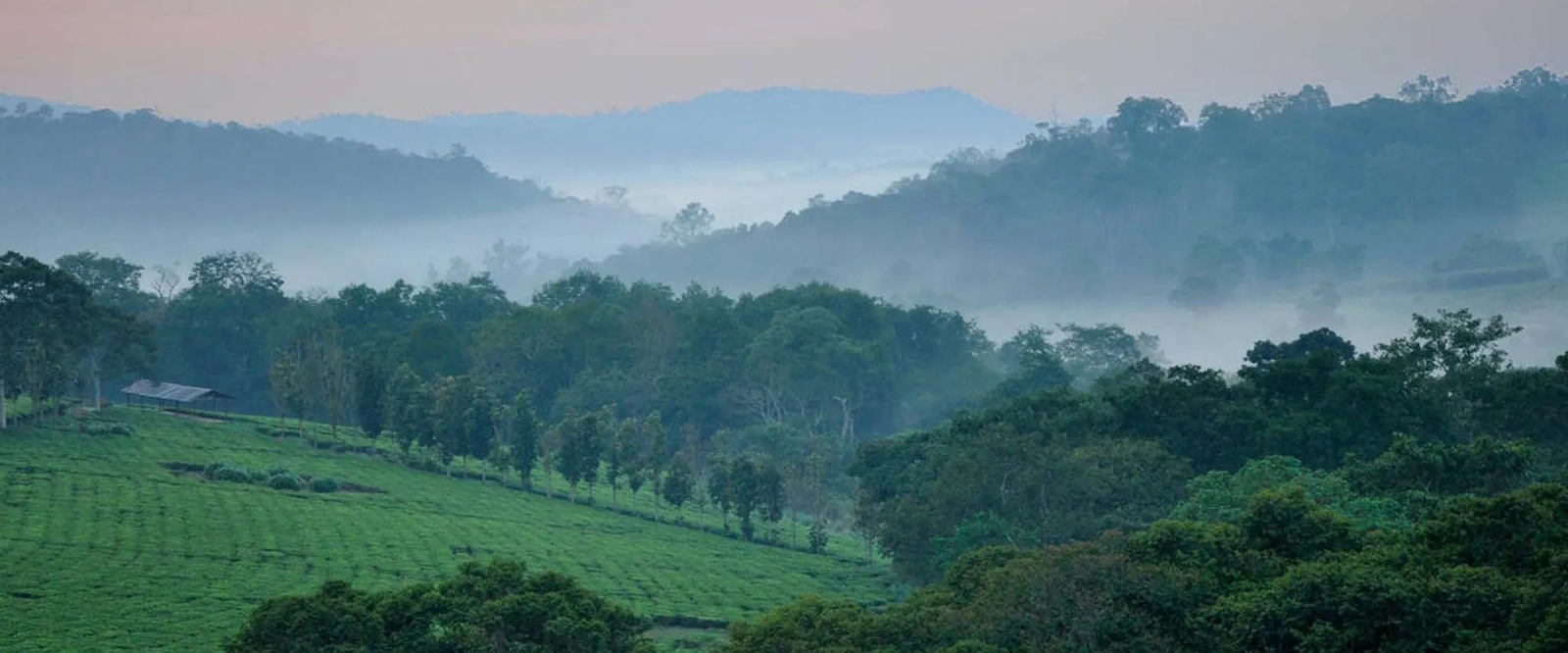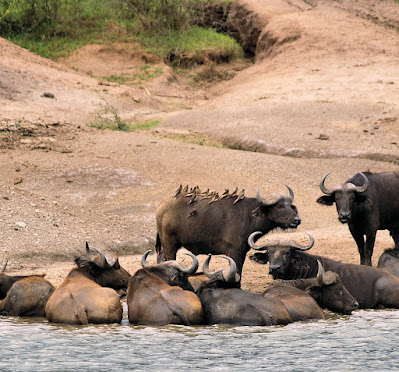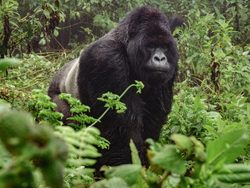Uganda, officially the Republic of Uganda,is a landlocked country in East Africa. It is bordered to the east by Kenya, to the north by South Sudan, to the west by the Democratic Republic of the Congo, to the south-west by Rwanda, and to the south by Tanzania. The southern part includes a substantial portion of Lake Victoria, shared with Kenya and Tanzania. Uganda is in the African Great Lakes region, lies within the Nilebasin, and has a varied equatorial climate. As of 2024, it has a population of 49.3 million, of whom 8.5 million live in the capital and largest city, Kampala.
Best Places For Birdwatching In Uganda
 |
Excellent birding at Mabamba Swamp, just an hour from Entebbe
Uganda is one of the most biodiverse countries in the world and one of the best places in Africa to enjoy bird watching. There are many sites to explore and spot rare species, with birding at Mabamba Swamp offering a particularly rewarding experience.
Mabamba Swamp is just over an hour’s drive from the busy town of Entebbe, and the same distance from Kampala. A tranquil area of wetland on the shores of Lake Victoria, it is renowned for its variety and abundance of birds and offers plenty of viewing and photography opportunities.
The shoebill
A visit to Mabamba Swamp (where several pairs of shoebills can be seen) is very special indeed. What’s more, because of its close proximity to Entebbe and Kampala, birding at Mabamba Swamp is a convenient choice for those who want to maximise time spent enjoying birdlife. It’s no surprise that it’s a popular choice for bird watchers who want to experience an excellent few hours of birding within easy reach.
It’s usually a good idea to try and visit in the morning, when shoebills mainly hunt for food. The extensive papyrus swamp has a labyrinth of channels and lagoons. Visitors must navigate through lily pads and papyrus to get closer to the birds.
What else is there to see when birding at Mabamba Swamp?
Mabamba Swamp is also home to the following:
- Lesser Jacana
- Papyrus Gonolek
- Orange weaver
- Black Egret
- Black Crake
- Black-faced Rufous Warbler
- Goliath heron
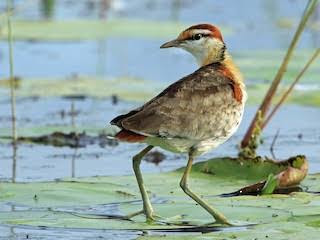 |
Lesser jacana |
 |
Orange weaver |
 |
Black heron |
 |
Black crake |
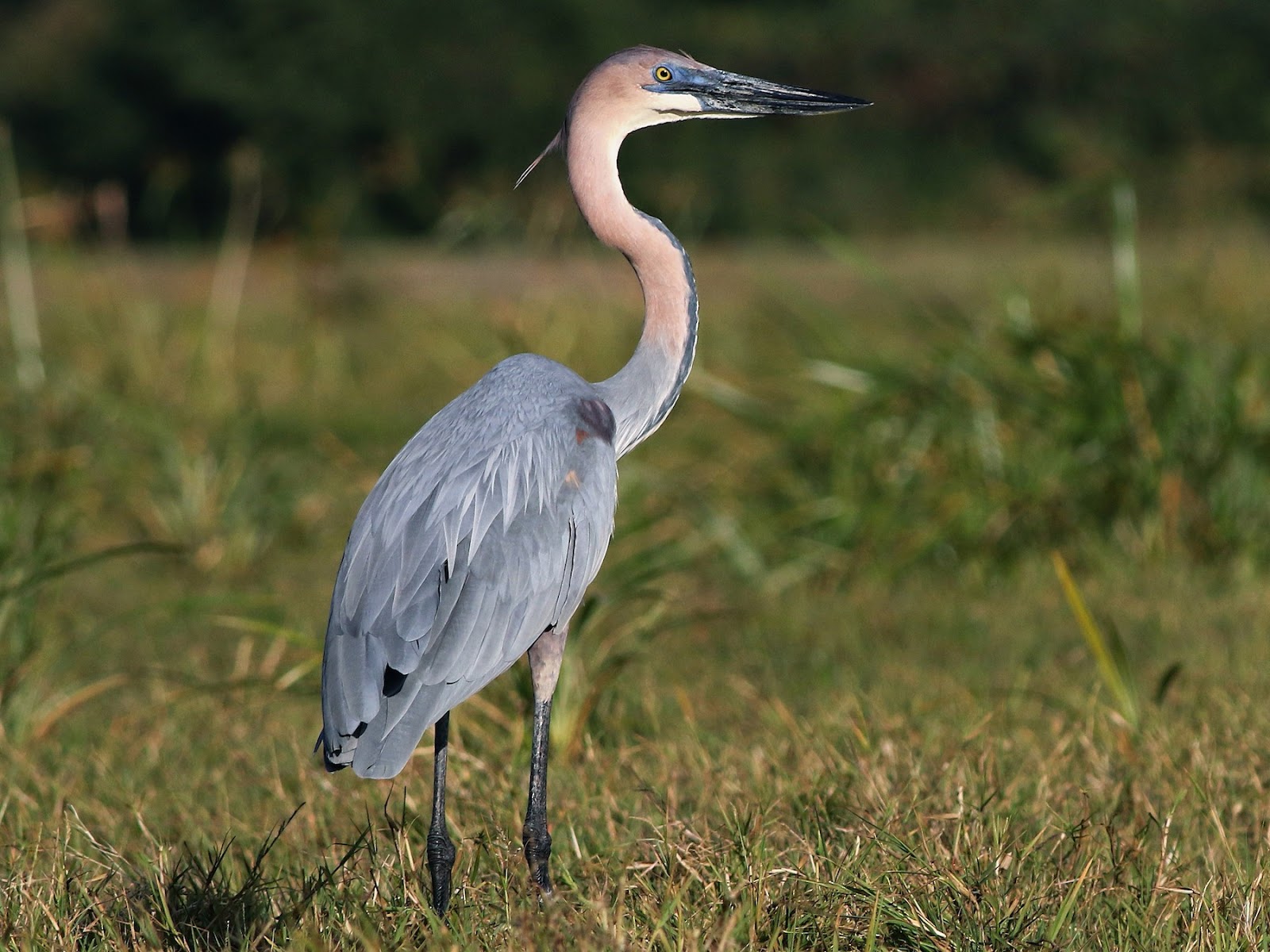 |
Goliath heron |
This enormous heron stands 1.5 meters tall and has a robust, dagger-like bill. The immature has rustier upperwings than the adult. Its flight is ponderous and labored. Goliath Heron inhabits large rivers, marshes, estuaries, and mangroves, hunting for large fish and other animals, stabbing them with an open bill. It has a distinct, barking “kowoork” call that can be heard from up to 2 km away. Purple Heron has similar plumage, but Goliath Heron is twice the size, has a much larger bill, and has a rufous (not blackish) top of the head.
 |
Black-faced rufous warbler |
 |
| Saddle-billed Stork |
Little Bittern, Osprey, Red-necked Falcon, Blue-breasted Bee-eater, Vinaceous Dove and Grosbeak Weaver. Other specials include Buff-bellied Warbler, Bar-breasted Firefinch, Yellow-fronted Tinkerbird, Red-winged Grey Warbler, Spotted Morning-Thrush, Marabou Stork and the Red-throated Bee-eater.
Birding in Uganda's Nile River is a popular activity, offering numerous opportunities to spot various bird species. The Nile River attracts a wide variety of birds, and birding can be done through boat cruises, kayak trips, and nature walks along the riverbanks.
Birding In Murchison Falls National Park
Why Murchison Falls is a Birdwatcher’s Paradise
Murchison Falls National Park is one of the most biodiverse parks in Uganda, and its rich birdlife is one of its biggest draws. The park’s varied landscapes, including Savannah grasslands, tropical forests, and wetlands, create diverse habitats that attract a wide range of bird species.
- Wetlands and Rivers: The Nile River, which flows through the park, provides an ideal environment for waterbirds such as kingfishers, egrets, and cormorants. The Delta area is especially renowned for its birding opportunities, where you can find birds like the Papyrus gonolek and the white-winged tern.
- Savannah: The park’s open savannahs are home to numerous raptors, ground birds, and large species like Secretary Birds and Hornbills. It’s also a good place to spot Bustards and Weavers.
- Woodlands and Forests: The forest zones of Murchison Falls, such as Budongo Forestand Kaniyo Pabidi, are perfect for spotting forest-dwelling species like Blue Turacos and Grey-crowned Cranes. These areas are also great for Woodpeckers and sunbirds
 |
| The secretarybird or secretary bird (Sagittarius serpentarius) is a large bird of preythat is endemic to Africa. It is mostly terrestrial, spending most of its time on the ground, and is usually found in the open grasslands and savanna of the sub-Saharan region. John Frederick Miller described the species in 1779. A member of the order Accipitriformes, which also includes many other diurnal birds of prey such as eagles, hawks, kites, vultures, and harriers, it is placed in its own family, Sagittariidae. Hartlaub's bustard A medium-sized, long-legged, long-necked bustard. The male has a striking black face pattern and a black line down the neck that connects to the black belly. The female is much plainer. In flight, shows a mostly white wing and a black rump. An uncommon species of grassland and savanna. Male is similar to male Black-bellied Bustard, but separated by blacker face with a cleaner white mark on the cheek. Females are very similar, but Hartlaub’s has a pale line down the faintly speckled neck. In flight, Hartlaub’s also shows less black in the wing and a black rump. The male Hartlaub’s gives a click, a pop, and a moan, which sometimes precede a display flight in which he jumps up into the air and then parachutes down. |
 |
| Grey-crowned crane |
 |
| African gray woodpecker |

 |
Tiny Sunbird |
The smallest member of a group of frustratingly similar double-collared sunbirds that co-occur in African forests. Often encountered near forest edges and in forest clearings, and sometimes even in villages and gardens.
Top Birdwatching Spots in Murchison Falls National Park
The park has several key birdwatching hotspots where you can see a wide range of species:
- The Nile River and Delta: The river itself and its delta area offer some of the best birding, with easy access to wetland species and migratory birds. The Murchison Falls is also a must-see, offering views of waterbirds and raptors in flight.
- Kaniyo Pabidi Forest: A great place for spotting forest species, such as Chimpanzee, as well as birds like Black-and-white-casqued Hornbill and Piping Hornbill.
- Budongo Forest Reserve: Known for its birding trails, Budongo has a variety of forest bird species, including Nahan’s Partridge, Brown-chested Lapwing, and the rare African Grey Parrot.
- Paraa Lodge Area: Near the park entrance, this area provides great opportunities to spot species like Vultures and Pelecanus.
 |
The chimpanzee (/tʃɪmpænˈzi/; Pan troglodytes), also simply known as the chimp, is a species of great ape native to the forests and savannahs of tropical Africa. It has four confirmed subspecies and a fifth proposed one. When its close relative the bonobowas more commonly known as the pygmy chimpanzee, this species was often called the common chimpanzee or the robust chimpanzee. The chimpanzee and the bonobo are the only species in the genus Pan. Evidence from fossils and DNA sequencing shows that Pan is a sister taxon to the human lineage and is thus humans' closest living relative.
Kaniyo Pabidi Forest
Black-and-white-casqued hornbill
Big, spectacular, black-and-white hornbill. The males have a large black-and-white bill, and females a much smaller all-dark one. In flight, shows a broad white patch at the back of the wing and a black tail with white sides. Found in thick forest and adjacent areas of lush woodland and cultivation. Usually in pairs or small groups. The loud calls are honking and yapping notes that are often given in a quick series. Similar to White-thighed and Brown-cheeked Hornbills, but has a black center to the tail, and the wingtips are black. Also has a darker bill and casque than those species
Reserve
The Budongo Forest is an important East African forest. This is because it is a particularly well-studied area and was, in the past, well-known for its mahogany.
 |
| Nahan's partridge |
 |
| Black-eared ground thrush |
 |
Grey parrot |
Kibale Forest National Park Uganda Safaris
Most people go to Kibale because they want to trek habituated chimpanzees through its verdant jungles but amongst other reasons why you should incorporate this park into your Uganda tour itinerary is its amazing avian diversity. The mosaic nature of different habitats ranging from thick primary forest through wetlands and grasslands ensures that there are many birds which can only be described as breathtaking thereby attracting both casual wildlife lovers and serious birdwatchers alike who may never want to leave the place once they set foot there.
 |
| Scarlet-chested sunbird |
The forests in the park are abundant and thick, so they provide a good environment for various kinds of birds that can hardly be seen elsewhere. The different forest strata at Kibale from the ground to the high canopy host an amazing number of species. No matter whether you are hiking through undergrowth or scanning treetops, you will meet lots of interesting birds.
 |
| Great blue torako in Kibali np. |
 |
Green-breasted pitta |
 |
| Bar-tailed Trogon |
Broad-tailed paradise whydah
Bigodi Wetland
The Bigodi Wetland Sanctuary is an fascinating area, located in Magombe swamp. this area is recognized for a extensive array of biodiversity among which are several primates species like the red colobus monkey, baboon, black & white colobus monkey, blue monkey grey cheeked, mangabey, vervet monkey, red tailed monkey and the L’Hoest monkey. Additional Mammals such as chimpanzees, Sitatunga, mongooses, bush pigs, otters plus bush bucks, also visit this swamp coming from the adjacent Kibale National Park.
The Bigodi is a paradise for bird watchers. Actually skilled birders can spot up to fifty new species on a bird list. Today, 138 species of bird have been recognized within the Bigodi Wetland Sanctuary. Oamong the major bird species within the sanctuary is the grand Blue Turaco.
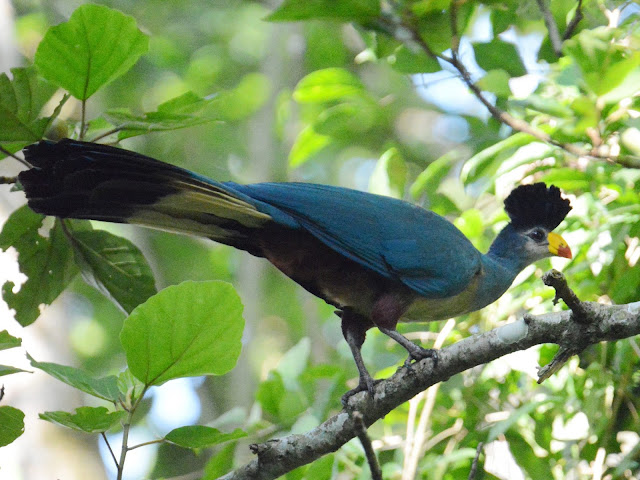 |
Great blue turaco |
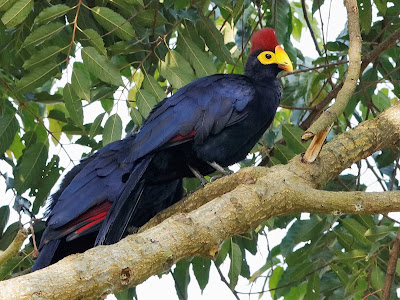 |
| Ross’s Turaco |
this swamp is supports more than 200 species of birds, among which is the most well-known bird – Great Blue Turaco (Corythaeola Cristata). The swamp is administered by the Kibale Association for Rural and Environmental Development (Kafred), and it actually benefits greatly from the adjacent Kibale National Park, since there are a number of primates such as the chimpanzees that occasionally visit the swamp, adding on the diversity of wild animals that tourists see within the Bigodi.
 |
| Black-billed Turaco |
 |
| Black-and-white-casqued hornbill |
Narina trogon
A spectacular, mostly iridescent-metallic-green bird, with a scarlet belly, broad yellow bill, and white under tail. The face and throat of the male are green, while the females’ are dirty gray-brown. It sits upright and still in the canopy of riverine and lowland forest, watching for insect prey, then flying fast and directly to catch it. During the breeding season, its soft, deep, throaty “huooo-huooo” call makes it much easier to find. The similar Bare-cheeked Trogon differs by having a face with a large bare yellow skin patches that extend from cheek to bill--not small blue-green spots. Bar-tailed Trogon has a heavily-barred undertail and prefers montane forest above 900 m.
 |
| Speckled mousebird at Bwindi NP, Uganda |
Extra more place to spot extra birds
Queen Elizabeth National Park
 |
| The tree climbing lions of Queen Elizabeth National Park |
Birdwatching In Queen Elizabeth, Birding Uganda
Queen Elizabeth National park boosts in an excess of 550 species of birds that have actually made it a charming destination for guests that love watching birds. The park is situated in Rukungiri district in southwestern Uganda covering a total land area of 1978 sq km. It sits at an altitude of 900 meters on the adjacent Lake Edward up to 1845 meters at the peak of the western Rift Valley’s – eastern Escarpment. It has a home of average altitude – moist semi-deciduous forest, rivine bush-land, moist thicket and riparian forest. Among the bird habitats offered within this national park are Open woodlands, rivers, open grassland, lakes seasonal as well as permanent swamps.
 |
| Pink and white backed Pelicans |
Water thick-knee
 |
| Knob-billed Ducks |
Maramagambo Forest
The Maramagambo Forest is one of the unique treasures that travelers should not miss while on a Uganda safari through Queen Elizabeth National Park. A lush contrast to the sprawling plains of Kasenyi and Ishasha, the Maramagambo Forest in the center of the park offers a very different experience for visitors
Lots of Things to See
Buzzing with primates, including L’Hoest’s, red-tailed, vervet and black and white colobus monkeys, chimpanzees and baboons, the forest is also alive with numerous bird species including the rare Forest
 |
| Rwenzori Turaco |
Bird watching
Birding in one of the best and rewarding safari experience offered in Maramagambo Forest. The birds to spot out at Maramagambo Forest include bat hawk, African green pigeon, Ross’s turaco, Rwenzori turaco, white napped pigeons, sulphur breasted bush shrike, dark caped yellow warblers, fawn breasted wax bill, forest flycatchers a mention but a few.The other exciting activity to do around Maramagambo forest is Kayaking at the Kyasanduka Crater One can visit the ‘cormorant house’, a large tree in the forest that has been turned white by the birds that roost in it at night.
 |
| fawn breasted wax bill |
 |
| sulphur breasted bush shrike |
Lake Mburo
LAKE MBURO’S CALL OF THE WILD

African finfoot
 A dark, elongated, duck-like, aquatic bird with neon orange bill and legs. The back and underparts are variably spotted and barred. The throat is gray in the male and white in the female. It swims slow and low in the water with its tail held on the surface. This secretive bird moves in pairs on perennial rivers, swamps, and quiet clear backwaters, foraging under overhanging cover for invertebrates, frogs, and fish. The short, thick neck and bright-colored bill and feet differentiate it from darters and cormorants.
A dark, elongated, duck-like, aquatic bird with neon orange bill and legs. The back and underparts are variably spotted and barred. The throat is gray in the male and white in the female. It swims slow and low in the water with its tail held on the surface. This secretive bird moves in pairs on perennial rivers, swamps, and quiet clear backwaters, foraging under overhanging cover for invertebrates, frogs, and fish. The short, thick neck and bright-colored bill and feet differentiate it from darters and cormorants.Lake Mburo’s history explains why it has remained a sanctuary of wilderness. Before it became a protected area, it was known for the culture of pastoralists who roamed its plains and hills as the “Karo Kurungi” (translated as “beautiful land”). The culture of the Banyankole Bahima people has been instrumental in preserving its beauty. Part of this is that the Bahima believed that the beauty of their Ankole cattle depended on preserving the pastoral beauty of the ancestral lands of Karo Kurungi. Ankole cattle, a breed of Sanga long-horned cattle, are well-adapted to living on sparse forage and minimal water and provide meat and very rich milk. The Bahima believed they had been charged with the care of the Ankole and that their cattle’s success depended on the land remaining beautiful – and thus unfarmed, uncropped and unfenced. This prevented other factions of the Banyankole – the Bahinda and Bairu farming class – from turning Karo Karungi into a production landscape of farms and
Bwindi
Impenetrable Natinal Park
Outstanding Universal Value
Brief synthesis
Bwindi Impenetrable National Park, covering 32,092 ha, is one of the largest areas in East Africa which still has Afromontane lowland forest extending to well within the montane forest belt. Located on the eastern edge of the Albertine Rift Valley and believed to be a Pleistocene refugium, the property is a biodiversity hotspot with
possibly the greatest number of tree species for its altitude in East Africa. It is also host to a rich fauna including a number of endemic butterflies and one of the richest mammalian assemblages in Africa. Home to almost half of the world’s mountain gorilla population, the property represents a conservation frontline as an isolated forest of outstanding biological richness surrounded by an agricultural landscape supporting one of the highest rural population densities in tropical Africa. Community benefits arising from the mountain gorilla and other ecotourism may be the only hope for the future conservation of this unique site.
Birds of Bwindi Impenetrable Forest
Bwindi Impenetrable National Park is one of Africa’s premier destinations for bird watching, drawing ornithologists and birding enthusiasts worldwide. The forest houses an impressive number of Albertine Rift endemics, species found only in this part of Africa. Notable examples include the African green broadbill, Grauer’s swamp warbler, and Shelley’s crimsonwing—species that are highly sought after by birders. Regional endemics add to the park’s specialised appeal, such as the handsome francolin, Doherty’s bushshrike, and the blue-headed sunbird. These endemics are supported by Bwindi’s dense vegetation, diverse altitudes, and abundant food sources, which create a critical refuge for species under pressure elsewhere due to habitat loss.
 |
| Shelley’s crimsonwing |
Shelley’s crimsonwing – no photos in natural habitat
 |
| Handsome Francolin |
 |
| Doherty’s bushshrike |
 |
| Blue-headed Sunbird |
In addition to its resident species, Bwindi provides a temporary home to various migratory birds that visit the park during specific times of the year. Several migratory species from Europe and Asia can be observed between November and April. These include the black kite, common cuckoo, and barn swallow. The influx of migratory birds enriches the birding experience and underscores the park’s role as a vital stopover in the African-Eurasian flyway.
Moroto
Mount Moroto is an ancient volcano whose name means “westward mountain” to the Karamojong people, signifying the mountain they initially saw when settling in this remote corner of
Karamoja’s bird habitat is Unique for Uganda
Semuliki National Park
 |
| crested malimbe |
- Semuliki National Park is home to about 40% of Uganda's total bird species and 66% of its forest bird species.
The Kirumia Trail, a 13km path through the forest, is a prime location for birdwatching, offering sightings of species like the White-crested hornbill and Yellow-throated Nicator. My Conclusion is a week is not enough for all of birds
The top ten Birds of Uganda (Most sought after on birding trips in Uganda)
 |
| Mgahinga Gorilla NP, Western, Uganda |
Rwenzori turaco
Atypical and beautiful multi-colored turaco. Like other turacos, shows large crimson wing patches in flight. Found in montane forest and secondary growth. Acts like a typical turaco, bouncing through the trees, and flying occasionally with short bursts of wingbeats and long glides. Found in pairs and sometimes small groups. Gives “kow” calls like other turacos, but also makes odd squirrel-like scolding calls and a 3-part “laser-gun” call.
 |
| Bwindi-Impenetrable NP--Mubwindi Swamp, Western, Uganda |
Grauer's broadbill A unique dumpy green flycatcher-like broadbill with a buffy crown, a black eye-stripe, and a powder-blue throat and vent. Juvenile duller. A scarce resident found singly and in pairs in the lower canopy and at middle levels of primary Albertine Rift Forest between 1760 and 2500 meters of elevation, preferring the edges of clearings. Highly localized, occurring in two isolated populations in Bwindi (Uganda) and Itombwe/Kahuzi (Democratic Republic of Congo), and inexplicably absent from ideal intervening habitat. May join flocks, but inconspicuous unless calling its soft high-pitched tinny “tsit-tsit,” repeated multiple times, and a rapid “tseet-tsit-tsit-sit-sit-it-it” in flight.
 |
| Lake Mburo NP, Western, Uganda |
Brown-chested lapwing
Large, long-legged upland shorebird. Note the rufous above the bill and below the gray hood. In flight, the top of the wing is black and brown, with a bold white stripe across the middle. Found in very open habitats including short grassland, recently burned areas, and lakeshores. Nomadic and migratory species that is generally uncommon. Often found in small flocks. Call is a high-pitched “chit-chit-chit.”
 |
| Bwindi-Impenetrable Forest NP--Entrance Road, Western, Uganda |
Jameson's antpecker
A small, slender-billed, warbler-like waxbill with pinkish-brown legs and different-looking sexes: the male has a red forehead, dull brown upperparts, and a rusty-chestnut face and underparts, while the female has a tawny-brown face and cheeks, pale buff underparts with scattered dark chevrons, and dull brown upperparts. Pairs and small groups forage by themselves or in mixed-species flocks, in the understory and middle levels of primary, secondary, and gallery forest, often near water. Eats insects, with a fondness for ants. Call is a high-pitched, downslurred “whseet.”
 |
| Kakum National Park, Central, Ghana (Bwindi-Impenetrable Forest NP--Buhoma, Western, Uganda) |
Black bee-eater
A bee-eater of forest and forest edge that appears entirely black at a distance, but in good light shows a bright red throat and electric blue belly, undertail, and chest spots. Western birds have a black eye-line bordered in blue. Unmistakable when seen well. Call is a sharp “ji-lip!” that is not often heard.
Important to note is that Uganda has only two endemic bird species, that is, Fox’s Weaver and Karamoja Apalis.
Find
1) the Fox’s weaver,
Uganda’s only Endemic
The rare Fox’s Weaver (Ploceus spekeoides) is Uganda’s only endemic bird. It is listed globally as a Near Threatened species. This bird’s preferred habitats are the papyrus-fringed lakes with nearby wooded grassland and seasonally flooded wetlands. These are common in the Eastern part of the country, including Lake Opeta, Bisina and sites towards Lira.
There have been reliable sightings of several nesting pairs in May 2018 near Lake Bisina by tour guides on a mission to find this elusive bird. This could be a sign that numbers are on the increase, although scientists are still carrying out research. Many ornithologists and bird watchers in Uganda long to see the Fox’s Weaver.
Looking for it is a challenge. You have to comb the wetlands and trudge through mud or floods – but when you find it, it is so rewarding!
2) The Karamoja Aparis in Uganda
Identification
The Karamoja Apalis (Apalis karamojae) is an East African endemic warbler primarily found in northeastern Uganda, northern Tanzania, and southern Kenya. In Uganda, it's concentrated in the Karamoja region, specifically areas like Kidepo Valley National Park, Mount Moroto, and Mount Napak. It's also been documented in the districts of Moroto and Napak. The bird prefers Acacia drepanolobium wooded grasslands
Finally
8 days Birding In Uganda (18 Oct to 25 Oct 2025)
 |
| Drawn by Nok veed |
Day 1 (18th Oct). Arrival at Entebbe International Airport and Drive to Accommodation and Dinner at Nimaro courts
http://www.jungjahut.com/2025/10/uganda-day1.html
http://www.jungjahut.com/2025/10/uganda-day2.html
Hyena Hill Lodge
Sanga Gate Lake Mburo National Park, Uganda tel:+256751898014
Lake Mburo National Park
http://www.jungjahut.com/2025/11/uganda-day3.html
Day 3 (20th Oct). Half Game Drive and transfer to Queen Elizabeth, Accommodation and Dinner at Kazinga Widerness Safari Camp
Day 4 (21st Oct). Full Game drive at Queen Elizabeth and Do Kazinga channel, Accommodation and Dinner at Kazinga Widerness Safari Camp
http://www.jungjahut.com/2025/11/uganda-birding-day4.html
Day 5 (22nd Oct). Early morning Drive to Kibale NP for Green-breasted Pitta then transfer to Semuliki Np.
Semuliki Forest National Park features the Uganda Wildlife Authority (UWA) managed Bandas and Campsite located at Bumaga, about 2.5km from Sempaya – a notable starting point for exploring the park and the nearby Semliki Game Reserve.
http://www.jungjahut.com/2025/11/uganda-birding-day5.html
Day 6 ( 23rd Oct). Full birding in Semuliki Np.
http://www.jungjahut.com/2025/11/uganda-birding-day6.html
Day 7 (24th Oct). Full day drive to Entebe


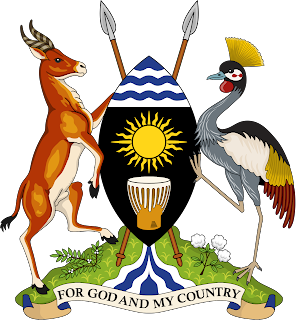

 Recommended for 7DAY trip
Recommended for 7DAY trip














